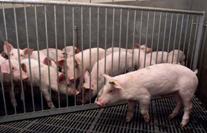Minimising antibiotic use with integrated gut management approach

Feed products designed for intestinal health have emerged to contribute to health management practices, generally focusing on promoting the growth of beneficial microbiota, and reducing pathogens. However, recent insights demonstrate that the efficacy of a gut health concept can be markedly improved by optimising both microbiota and intestinal barrier function. This integrated approach includes stabilisation of the microbiota and enforcing the mucosal barrier properties.
Economic importance of diarrhoea and gut health issues in farm productivity needs no new introduction. In the European scenario, animal farming is characterised by a greater challenge to maintain gut health since the ban on antimicrobial growth promoters, the more recent pressure on usage of therapeutic antibiotics and the need for zinc oxide alternatives in prevention of diarrhoea in piglets.
In modern day high throughput farming, stress on the production animals is inevitable. Every animal goes through it to some extent. Stress can be multi-factorial including disease pressure, transportation, vaccination, feed transitions and environmental factors. In recent scientific literature, it has become more evident that stress plays a major role in disturbing the gut environment and setting up gut health challenges. There are essentially two ways, by which stress contributes to gut health problems: by causing microbial imbalance or dysbiosis and by causing systemic changes in the animal leading to loss of gut barrier integrity.
Microbial dysbiosis along with gut barrier dysfunction causes poor digestion and immunity problems, such as inflammation. These, in turn, can lead to poor feed efficiency and daily gain as well as diarrhoea and infections. For the farmer, this means more use of drugs, increased veterinary costs, high mortality rates and – ultimately – financial loss.
Microbiota management
in literature and include the mucus layer, the permeability of the epithelial cell layer covering the intestinal mucosa and the response of the gut associated immune system.
The very first thing that needed to be solved, was to find a reliable and reproducible in vivo model to study barrier function in nutritional intervention studies. This led to the development of a novel gut barrier stress model in collaboration with leading universities in this field of research. The model induces a gut barrier dysfunction and various parameters that are critical in relation to gut barrier function can be studied. Attention for example is paid to various tight junction and inflammation parameters. Tight junctions are proteins that keep the epithelial cells together in order to prevent a ‘leaky’ gut. Inflammation may be the result of a leaky gut, but also vice versa inflammation may be the causative factor for a leaky gut by damaging the mucosa.
Various nutritional compounds were tested in the gut barrier model in pigs and poultry, resulting in the identification of substances that were capable of reversing the adverse effects induced by the stress model and were further studied in the test blends. Two examples are illustrated in the Figures 3 and4 of results obtained with broiler chickens. The results demonstrate that the stress challenge induced significant changes in the expression of tight junction proteins and inflammatory processes and that the addition of compounds with anti-inflammatory properties was able to reverse these effects. Maintenance of a high level tight junction protein production is vital for prevention of a ‘leaky gut’ and moreover, control of inflammation prevents further damage to the mucosa.
Combination improves health
The combined application of microbiota management with concepts for support of gut barrier function is likely to be a very powerful approach to prevent the risk of dysbiosis, impaired barrier function and subsequent performance and health problems.
Promising results have been obtained in piglet and broiler performance studies in the Netherlands and Spain, testing the combination of these microbiota and gut barrier management strategies. These studies show significant improvements in feed efficiency, daily feed intake and daily gain. Furthermore diarrhoea incidence in piglets and wet litter scores in broilers were significantly reduced. At this stage extensive validation studies and field trials are on-going to confirm and further support these findings.
For further information Dr. Jaco Eissen can be contacted at: jaco.eissen@nutreco.com
Authors would like to acknowledge scientific partners from NIZO Food Research, Utrecht University, Wageningen University and INRA for their valuable scientific support.
Authors:
Ajay Awati and Coen Smits, Nutreco R&D, the Netherlands











